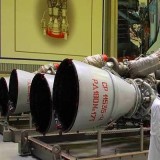US Navy’s future F/A-XX sixth-generation fighter to address current gaps in strike and air superiority

{loadposition bannertop}
{loadposition sidebarpub}
As reported by Zona Militar on November 27, 2024, the US Navy is advancing towards the development of the F/A-XX, its sixth-generation fighter program, to replace the F/A-18E/F Super Hornet and EA-18G Growler while complementing the F-35C in carrier air wings. The program is being developed independently of the US Air Force’s Next-Generation Air Dominance (NGAD) initiative, as Rear Adm. Michael Donnelly, director of the Air Warfare Division in the Office of the Chief of Naval Operations, recently stated that the F/A-XX is focused on affordability, versatility, and multirole functionality, differing from the NGAD program’s focus on air superiority.Follow Army Recognition on Google News at this link
The F/A-XX will operate within carrier air wings as part of the US Navy’s Next Generation Air Dominance (NGAD) family of systems, cooperating with unmanned aircraft. (Picture source: Boeing)
The US Navy has chosen a propulsion strategy for the F/A-XX based on derivative engine technology rather than the adaptive-cycle engines under development for the Air Force’s NGAP initiative. This approach aligns with the Navy’s specific operational needs and aims to mitigate risks associated with unproven technologies. According to Donnelly, this decision reduces the likelihood of delays and cost overruns that have affected other programs, maintaining consistency with the Navy’s overall acquisition strategy.
The F/A-XX is being designed as a multirole aircraft capable of fulfilling air-to-surface missions while retaining air-to-air capabilities. This design reflects the Navy’s preference for platforms that can address multiple mission scenarios within the existing carrier air wing structure. Although some analysts have raised concerns about potential gaps in the Navy’s deep-strike capabilities, particularly in the absence of a replacement for the retired A-6E Intruder, the Navy maintains that the F/A-XX will meet its long-range strike and fleet defense requirements. The platform is expected to integrate with unmanned systems, such as the Boeing MQ-25 Stingray, as part of a move toward incorporating hybrid air wings combining manned and unmanned systems. Initial concepts included both manned and unmanned variants, but the current focus is on a fully manned design.
The F/A-XX will operate as part of the Navy’s Next Generation Air Dominance (NGAD) family of systems. It is expected to feature advanced connectivity for networked operations and capabilities for long-range precision engagements. Planned integration with technologies such as advanced sensors, artificial intelligence, and unmanned assets like the MQ-25 Stingray is intended to enhance its operational effectiveness. While the Navy is proceeding with these plans, budgetary constraints have introduced significant challenges to the program.
The Navy’s fiscal 2025 budget reduced planned funding for the F/A-XX program by 67%, from $10.3 billion to $3.3 billion over four years. Senate appropriators proposed restoring $450 million, yet the funding still represents a 59% reduction compared to earlier plans. These financial adjustments may affect the development timeline, including the Navy’s goal of achieving a Milestone B decision for the engineering and manufacturing development phase by the end of fiscal 2025.
The program’s requirements remain focused on stealth, connectivity, and multirole functionality, with an emphasis on air-to-surface capabilities alongside air-to-air performance. This approach distinguishes the F/A-XX from the Air Force’s NGAD program, which is more oriented toward air superiority. Despite reduced funding, the Navy has not altered its design or performance criteria. Major defense contractors, including Boeing, Lockheed Martin, and Northrop Grumman, are competing for the prime contractor role, with a decision expected next year. Since its first market survey in 2012, the F/A-XX program has progressed through concept development and remains a key element of the Navy’s future carrier-based air operations.

{loadposition bannertop}
{loadposition sidebarpub}
As reported by Zona Militar on November 27, 2024, the US Navy is advancing towards the development of the F/A-XX, its sixth-generation fighter program, to replace the F/A-18E/F Super Hornet and EA-18G Growler while complementing the F-35C in carrier air wings. The program is being developed independently of the US Air Force’s Next-Generation Air Dominance (NGAD) initiative, as Rear Adm. Michael Donnelly, director of the Air Warfare Division in the Office of the Chief of Naval Operations, recently stated that the F/A-XX is focused on affordability, versatility, and multirole functionality, differing from the NGAD program’s focus on air superiority.
Follow Army Recognition on Google News at this link
The F/A-XX will operate within carrier air wings as part of the US Navy’s Next Generation Air Dominance (NGAD) family of systems, cooperating with unmanned aircraft. (Picture source: Boeing)
The US Navy has chosen a propulsion strategy for the F/A-XX based on derivative engine technology rather than the adaptive-cycle engines under development for the Air Force’s NGAP initiative. This approach aligns with the Navy’s specific operational needs and aims to mitigate risks associated with unproven technologies. According to Donnelly, this decision reduces the likelihood of delays and cost overruns that have affected other programs, maintaining consistency with the Navy’s overall acquisition strategy.
The F/A-XX is being designed as a multirole aircraft capable of fulfilling air-to-surface missions while retaining air-to-air capabilities. This design reflects the Navy’s preference for platforms that can address multiple mission scenarios within the existing carrier air wing structure. Although some analysts have raised concerns about potential gaps in the Navy’s deep-strike capabilities, particularly in the absence of a replacement for the retired A-6E Intruder, the Navy maintains that the F/A-XX will meet its long-range strike and fleet defense requirements. The platform is expected to integrate with unmanned systems, such as the Boeing MQ-25 Stingray, as part of a move toward incorporating hybrid air wings combining manned and unmanned systems. Initial concepts included both manned and unmanned variants, but the current focus is on a fully manned design.
The F/A-XX will operate as part of the Navy’s Next Generation Air Dominance (NGAD) family of systems. It is expected to feature advanced connectivity for networked operations and capabilities for long-range precision engagements. Planned integration with technologies such as advanced sensors, artificial intelligence, and unmanned assets like the MQ-25 Stingray is intended to enhance its operational effectiveness. While the Navy is proceeding with these plans, budgetary constraints have introduced significant challenges to the program.
The Navy’s fiscal 2025 budget reduced planned funding for the F/A-XX program by 67%, from $10.3 billion to $3.3 billion over four years. Senate appropriators proposed restoring $450 million, yet the funding still represents a 59% reduction compared to earlier plans. These financial adjustments may affect the development timeline, including the Navy’s goal of achieving a Milestone B decision for the engineering and manufacturing development phase by the end of fiscal 2025.
The program’s requirements remain focused on stealth, connectivity, and multirole functionality, with an emphasis on air-to-surface capabilities alongside air-to-air performance. This approach distinguishes the F/A-XX from the Air Force’s NGAD program, which is more oriented toward air superiority. Despite reduced funding, the Navy has not altered its design or performance criteria. Major defense contractors, including Boeing, Lockheed Martin, and Northrop Grumman, are competing for the prime contractor role, with a decision expected next year. Since its first market survey in 2012, the F/A-XX program has progressed through concept development and remains a key element of the Navy’s future carrier-based air operations.





